03 July, 2025
Miriam had business to deal with in Burlington, so we packed a lunch to make a day of it.
Initially we had planned to spend most of our time at LaSalle Park, but a movie was being shot there and all the parking spaces were occupied. Furthermore, the public was excluded from many sections of the shore, so we headed elsewhere.
It was our good fortune to discover Hidden Valley, a location previously unknown to us. It is part of the extensive Cootes Valley network of trails, much of which we have explored.
A member of the Bot Flies, Blow Flies and Allies (superfamily Oestroidea) joined us for lunch; remarkably well-behaved I must say, never bothering us for a moment.
An Eastern Black Walnut tree seemed to be shedding its fruit unduly early, perhaps due to heat stress and lack of moisture.
Ebony Jewelwing (Calopteryx maculata) is at peak abundance at this time of year and it was enjoyable to see them often - sometimes several together, with males vying for mating rights. Sound familiar?
Ebony Jewelwing ♂
Ebony Jewelwing ♀
How lovely is a Buttercup (genus Ranunculus)?
Pale Jewelweed (Impatiens pallida) is seldom found far from water; I doubt that anyone could dispute that it is exquisitely beautiful, a symmetry of perfection.
It took me a while to identify the following plant and I am still a little uncertain. However, I have concluded that it is Nipplewort (Lapsana communis). Originally from Europe and Asia, it has become widely cosmopolitan throughout the Americas.
The moth on it proved to be equally puzzling. As best I can determine it is Aetole bella, a species new to me and probably uncommon in Ontario. I have been able to find very little to confirm or refute my judgement, however, and remain open to confirmation or correction.
A land snail, either Cepaea nemoralis or C. hortensis did its best to stay out of the hot sun.
A Northern Crescent (Phyciodes cocyta) added joy to our day.
A Western Honey Bee (Apis mellifera), that most cosmopolitan of the Apidae, foraged on Common Motherwort.
This species is frequently misnamed as Deadly Nightshade, the common name of Atropa belladonna, a deadly poisonous species not found in Ontario. No novels about the nefarious conduct of wronged spouses will be written about S. ducamara, unfortunately. There are a few mushrooms that would do the trick though!
This beautiful lady is a Coneflower Mining Bee (Andrena rudbeckiae) busily going from flower to flower.
The dining technique of spiders in this family (Orb Weavers) involves external disgestion. Digestive juices are vomited onto prey to break it down before sucking it up.
Dinner anyone?
A Transverse-banded Flower Fly (Eristalis transversa) is both common and beautiful.
It's probably a good thing that Eastern Black-headed Nemognatha (Nemognatha nemorensis) doesn't have to fill out one of those government forms where you are only permitted so many squares for the letters of your name.
I wonder what happens when someone has a moniker like Aloysius Ryerson Goldberg-Sanderson! And double-barreled names seem to be on the ascendancy these days.
Black Raspberry (Rubus occidentalis) will soon be at its lip-staining, chin-dripping best.
The fruit of American Black Elderberry (Sambucus canadensis) may be used for a whole range of delectables, from wine to preserves.
We are aways thrilled to see a Common Raccoon (Protyon lotor), as long as they don't take up residence in our attic.
Ants are not easy to identify for the non-specialist, but I believe this is a member of the Citronella Ants, Fuzzy Ants and Allies (genus Lasius).
Fleabanes are delightful little flowers, many species looking quite similar. I am pretty confident this is Annual Fleabane (Erigeron annuus).
By crossing the road we joined up with trails more familiar to us and considered ourselves fortunate to have discovered a series of interlinked nature walks.
We marched on - well ambled would be a better description, stopping for everything that captured our attention. One does not aim for speed records on perambulations in nature!
I think this is Upright Hedge Parsley (Torilis japonica).
To my eye, Water Forget-me-not (Myosotis scorpioides) is the very definition of perfection.
Creeping Jenny (Lysimachia nummularia) is a wonderful yellow exclamation point at the woodland edge.
Holarctic Azures (genus Celastrina) are often reluctant to land so Miriam has to be quick with the camera when they do.
We came across if not the largest Common Snapping Turtle (Chelydra serpentina) we have ever seen certainly close to it.
I once read somewhere that hyperbole and exaggeration is rife in the estimation of the size of snappers. I believe that!
One thing I am sure of, however, is that I have never previously seen one in such a rapidly flowing stream. It had no difficulty dealing with the torrent and it re-entered the water before we left.
Here is Hedge Bindweed (Calystegia sepium) with an unidentified insect.
Riverbank Grape (Vitis riparia), as the name implies, is commonly found along the banks of streams and creeks in southern Ontario.
As we neared the end of our return stroll back to the car, another mullein was reaching for the sky.



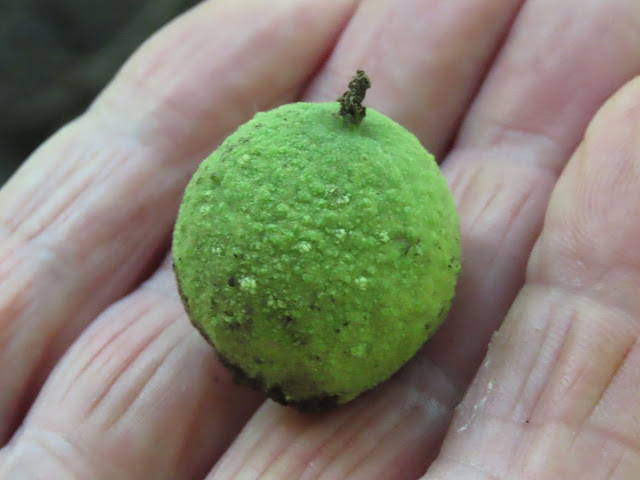


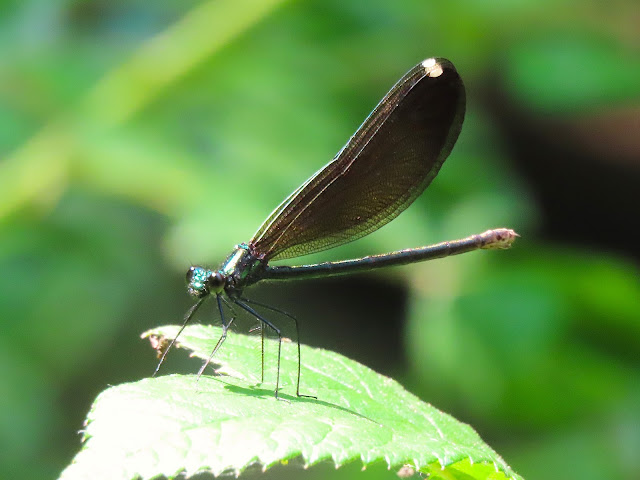



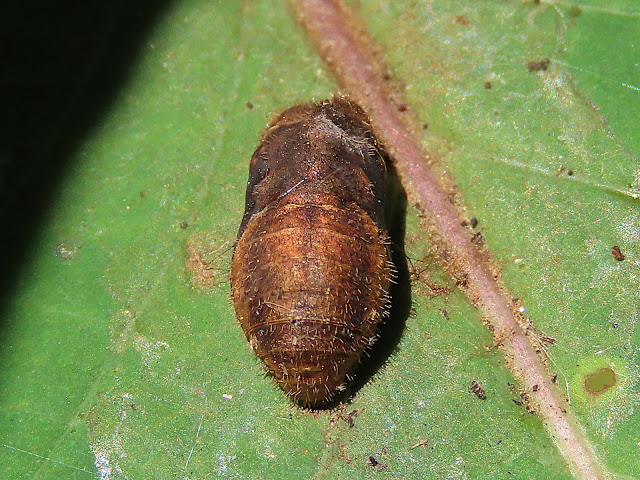













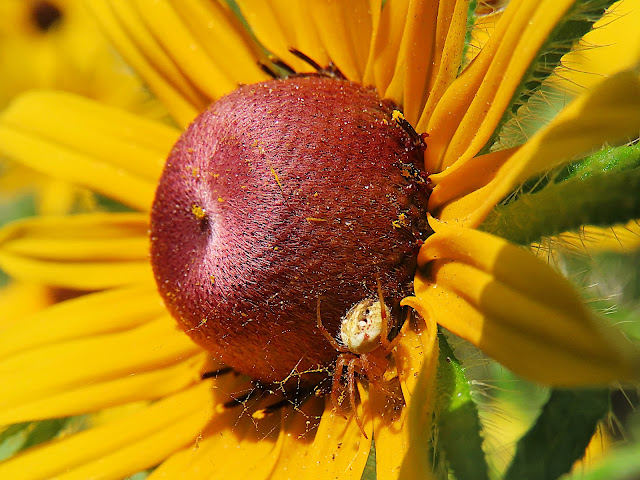



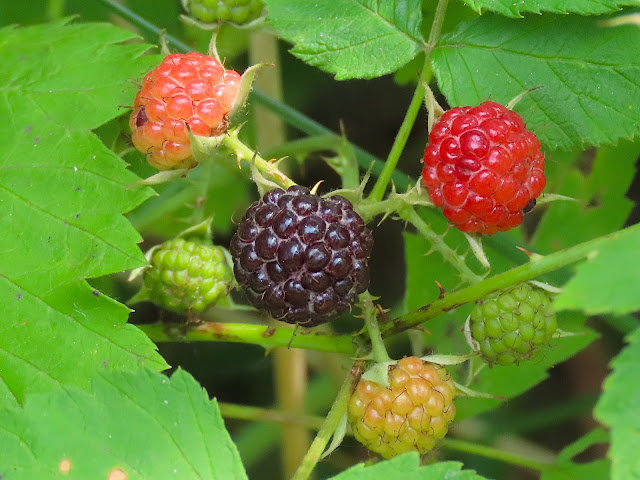


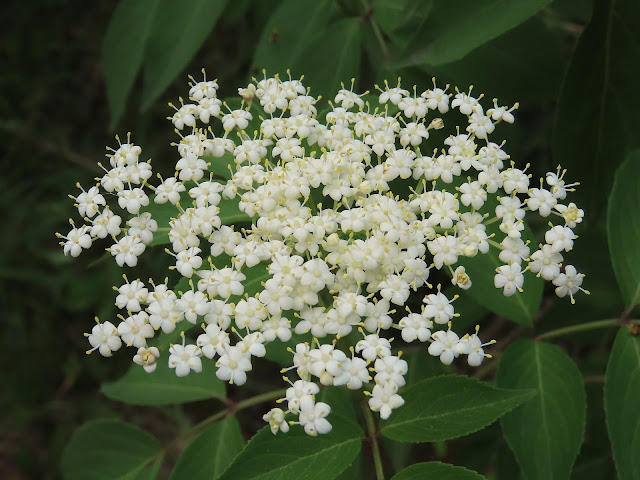






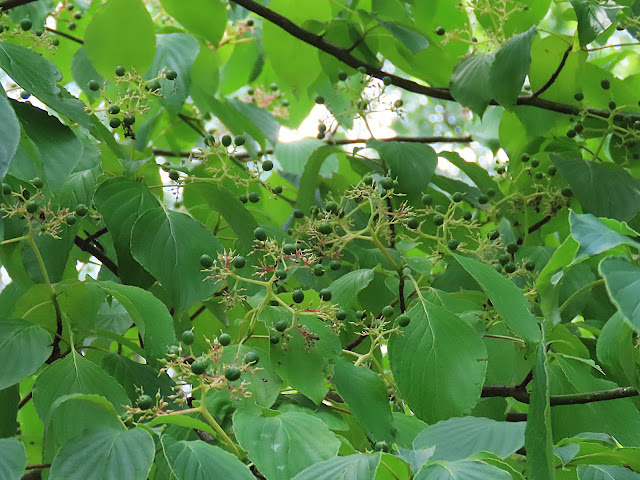
















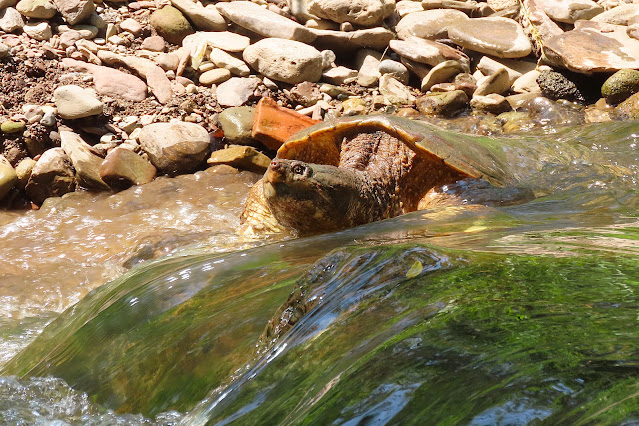





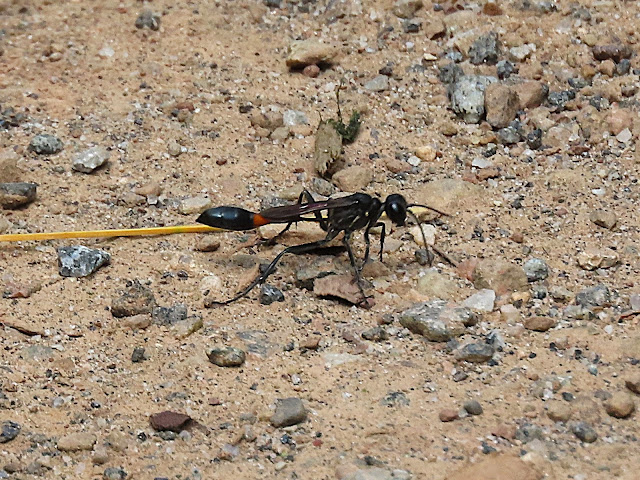





















Lots of lovely flowers and other life which I love but no birds! I've seen only two butterflies so far this year.
ReplyDeleteThere were birds but it was a hot afternoon and mostly they were quiet and resting deep in the foliage.
Delete...the arrival of chicory signals the summer is well underway!
ReplyDeleteLovely pictures, all - even the snapping turtle! I've been enjoying the black-eyed Susan and fleabane that are in bloom in my yard.
ReplyDeleteYes, it`s a little paradise, this Hidden Parc. And I enjoyed this virtual walk very much. Especially this many details of nature around the way.
ReplyDeleteHave a very good week!
Gorgeous captures, David.
ReplyDeleteThe flowers are really beautiful and the insects. It would be nice to see and photograph a raccoon someday.
ReplyDeleteThat's a wonderful blog post you have today, David. You show a lot of nice flowers today. Rudbeckia hirta is a very nice flower. I really like them. Mine change color every year, so they must be a cross. The Chicory is also a beautiful flower. We have Ticks around here too.
ReplyDeleteHugs and kisses, Marit
Lovely pictures and info on the critters. Love the "susans", whether black or brown eyed...they are a favourite.
ReplyDeleteI hope that tree survive the heat... I have absolutely no idea of names of so many flowers you have showed here...Black-eyed Susan is always a favourite.
ReplyDeleteThen you have learned something today, Angie!
DeleteThe snapping turtle shots are great! I'm sure it must have been amazing seeing this giant.
ReplyDeleteIt really was. We see snapping turtles quite often but rarely as big as this one.
DeleteLovely photos of the critters and flowers. The Common Snapping Turtle is very impressive, it's the first one I've ever seen and the Ebony Jewelwing is a beauty.
ReplyDeleteHow wonderful that you found a new-to-you area to explore! I saw a snail that looked just like that on my way home from the library today. We have lots of snails in shells of many different colors and patterns. Miriam's photos are a real joy to see, as always.
ReplyDeleteSo many wonders today. I'd never seen chicory.( I always think of New Orleans.) Love the turtle pic and the Black-eyed Susans. The racoon is awfully cute. The tick signs are a good idea. The HH got me some double petal orange day lilies that I'm looking forward to seeing next year. I thoroughly enjoyed our trek. Thanks for letting us tag along.
ReplyDeleteHari OM
ReplyDeleteOh, this was a sheer delight - something a little different - particularly that turtle! YAM xx
What a beauty, huh?
DeleteLove the blossoms, insects, raccoon and turtle. A new area to explore is always a great find.
ReplyDeleteHallo David,
ReplyDeleteEen blog met soorten waarvan sommigen hier ook voorkomen, maar een groot deel van vooral de planten en insecten ken ik niet. Wat leuk dat jullie zoveel zagen in een tot dan toe voor jullie onbekend gebied, zo zie je maar dat waar je ook komt de natuur altijd verassingen in petto heeft. Knap dat je dan in zo'n nieuw gebied zo'n reportage kunt maken.
Groeten,
Ad
A lovely post, I enjoyed seeing your photographs.
ReplyDeleteThe Common Raccoon looks cute in the tree.
All the best Jan
I love that little jewelwing. Lots of ticks here too, along with alpha gal issues for many.
ReplyDeleteI admire your ability to remember all the names of the many plants and animals (particularly insect) species you come across.
ReplyDeleteLovely photos of the flowers, I'm not nearly as big a fan of the bugs, but the raccoon was adorable.
ReplyDeleteIt’s not a question of being a fan, it’s simply the recognition that they are critical to a successful and healthy environment.
DeleteWhat a find, Hidden Valley! a walk full of life, I loved how the little yellow flowers looked like suns guiding the way; at any moment, I found myself in Alice in Wonderland. The raccoon and all the little bugs were adorable, especially the spider—she was so tender XD
ReplyDeleteThank you for sharing such beauty captured with big love
🌸A big kiss. Gros bisous, mon ami!
Thank you for sharing all these interesting sights from your walk. Always an education and one I enjoyed very much.
ReplyDeleteThanks for taking us along. The turtle is looking good and very interesting to see.
ReplyDeleteLove all the bloom, some so very pretty.
Beautiful photos, David.
ReplyDeleteThe flowers and insects are truly stunning.
The snapping turtle and the raccoon are also wonderful to see.
We do see a raccoon at the zoo, but the snapping turtle is new to me, I didn't know it existed.
Greetings Irma
¡Qué suerte tienes, David!
ReplyDelete¡Feliz día!
Tengo una nueva entrada en mi blog.
I find it's always exciting to discover a new place to walk, and you found a good one. Wow, what a variety of species. Maybe it's a good thing they were shooting a movie. Thanks for sharing these great photos. hugs-Erika
ReplyDeleteAnd there were many other species too, Erika. These are the ones we got pictures of.
DeleteA wonderful adventure once again David. Great photos :-D
ReplyDeleteTicks are pretty common here too. I have a tick hook in my walking backpack.
You have introduced me to a new tool, Ananka!
DeleteA feast for the eyes David. We would stay on Manitoulin Island in the summer and the lodge had two tame racoons on the premises. Abandoned as babies and raised by hand. the funniest creatures ever. Opened purses and dove into guests' pockets. House trained.
ReplyDeleteXO
WWW
As I was reading and scrolling through your post and enjoying all of the lovely photos, I was feeling inspired to visit a local park to enjoy all of the creatures of nature- until I saw the sign about the tics in your post and then I remembered why I stopped visiting our local parks for outings!! Have a great day.
ReplyDeleteIf you take reasonable precautions you can deal with ticks. It's a shame not to get outside.
DeleteHello David :)
ReplyDeleteHow I have missed seeing your posts, and it's with great pleasure that I visit you today and you never disappoint This is a beautiful visual array of plants and other wild life that I do not see where I live. such as the raccoon, snapping turtle, and butterflies, especially the blue one which Miriam managed to take a fine photo of. Because I love the colour blue, the Water Forget-me -not is always a wonderful discovery and I must say that discovering The Hidden Valley was also a great encounter, teaming with plant and insect life- As always an enlightening and delightful post.
Hugs and Kisses
Sonjia.
Great discovery of a new walk to take. The biggest snapping turtle I've seen was in the road when we were exploring one of the 1000 Islands. I didn't get close.
ReplyDeleteSo very beautiful David. You and Miriam turned a roadblock, into a discovery. How nice for us to see these beautiful pictures! Thank you both. Aloha!
ReplyDeleteWhat a great discovery!....I love those black raspberries. I have them here as well. I was tempted to pick them, but is the food of the deer we have around!.......Abrazotes, Marcela
ReplyDeleteHidden Valley was so hidden you'd never seen it before ;) That was quite the outing. Lots to see. And just think, if they hadn't been shooting that movie, you would have missed it.
ReplyDeleteSome nice closeups and identifications of wildflowers. I wonder what the movie was all about. They'll probably spend mega$$$ and lots of time shooting, then only 5 minutes showing that location will end up on the screen.
ReplyDeleteYou are probably right, and judging from the equipment and personnel there it was an expensive shoot.
DeleteQuite a micro of bugs, bees, and blooms today, David! What is found interesting is that some things are flowering at the same time, where here some of those would have been spring blooms, like the buttercup, and others like the black-eyed Susans would be later, in summer. I suppose that geing further north crowds the bloom time?
ReplyDeleteLovely butterflies, most new ro me!
Hello David,
ReplyDeleteeven new paths have something beautiful to offer, it's good that film footage has led you there, very nice plant pictures and a raccoon, great trip, greetings Frank
You happened upon a gold mine, so much to unwrap and enjoy in new to you Hidden Valley!
ReplyDeleteMy husband and I are Texas Master Naturalists and we participate in a citizen science project that looks at butterflies, so I am delighted to see your photos of the butterflies you ran across during your walk. The only one we see here along the Upper Gulf Coast of Texas that you photographed in this post is the Pearl Crescent, but we see similar butterflies to your Small White, Northern Crescent, and Holarctic Azures.
ReplyDeleteHow nice to find a brand new place to take a walk! It is full of surprises. Beautiful flowers, insect and the Common Raccoon, Wow, sensational! Have a nice weekend, Greetings Maria
ReplyDeleteThose jewel wings do look like flying jewels, don't they, David?
ReplyDeleteVomiting on my dinner before I eat it is not appealing! Ain't need your brand? Beautiful pictures Miriam... I love the raccoon.. No birdies this time?? Too hot??? It doesn't keep them away from my feeders.... Nice that you found a new place to meander with new bugs and critters. Hugs
ReplyDeleteSuch exquisite photos by Miriam, David - I enjoyed them very much. Those little bandits (aka raccoon) come into our backyard almost every night and make quite the racket. Not long and mother raccoon will bring along her young ones as well. I love the many plants you saw, the picture of the rudbeckia at the side of the path is wonderful! Yes, ticks can become a real problem - we have them here, too, but they're not as bad as on the East Coast (not yet, at least). Today I went to the lake and couldn't remember where I had put the tick repellent that I had just bought, so I just stuck my hiking pants in my hiking socks and did a tick check every now and then. No tick, but if there was one I could still hope it had a good meal on a Western Fence Lizard first, then I wouldn't have to worry.
ReplyDeleteThank you for taking us along Hidden Valley (our old neighborhood was called Hidden Valley), what a beautiful outing. Big hugs - Carola
Thank you for sharing your interesting walk. The raccoon is adorable!
ReplyDeleteI would have thought by now you'd have discovered everything, so finding a new spot must have been exciting. It looks like a good one too, with plenty of lovely finds. A great and serendipitous day!
ReplyDeleteWell, after all, it is Hidden Valley, Jeanie!
DeleteI so enjoyed this walk with you. I am glad the carpark was full and you found this beautiful spot. As always beautiful photos and excellent write ups, it is like being there with you both. Bisous mon ami. Time is still not on my side! Cheers Diane
ReplyDeleteQuerido amigo David, has hecho un reportaje precioso de los que me gustan a mí. Abrazos.
ReplyDeleteHi David - wonderful memories of the plants and wildlife you found in your hidden valley - sounds an ideal treasure trove of nature. Cheers Hilary
ReplyDelete